- Published on
YouTube Ads Tutorial 2023
- Authors
- Name
- Khushi Nayyar

🎯 Goal
🙏 Namaste
In this practical tutorial, you will learn:
- Why should you choose YouTube advertising?
- Types of YouTube advertising
- How to launch a YouTube ad campaign
- How to optimize YouTube advertising
We will dive into each step, providing practically steps you can implement to launch a successful ad campaign.
Why should you choose YouTube advertising?
YouTube Ads have a significant selling point which is the powerful impact on video on memory, making it easier for individuals to recall your brand.
With a whopping 2 billion monthly active users, YouTube ranks among the largest platforms on the internet. No other platform comes close in terms of the breadth and depth of its engaged audience base.
If you address the needs of your target audience, you can discover potential customers on YouTube with certainty, given the platform's extensive traffic.
YouTube can be an incredibly valuable channel for businesses seeking to:
- Boost brand awareness
- Generate leads
- Drive conversions
Types of ad campaigns
Google has provided an overview of the basic formats for various types of video ads that you can invest in on YouTube. We will delve deeper into each of these formats in the following section.
1. In-feed video ads
In YouTube, the in-feed video ads appears on the homepage, search results pages, and as related videos on video watch pages.
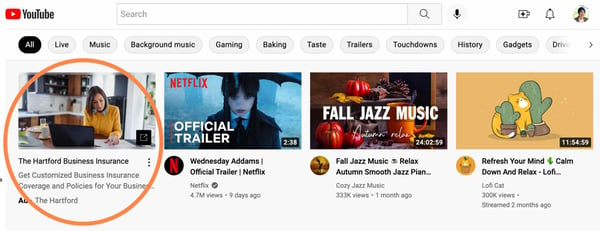
2. Skippable in-stream video ads
The standard type of video ad on YouTube is skippable in-stream ads, which advertisers only have to pay for when a user watches the ad for :
- At least 30 seconds
- Until the end of the video
- The viewer takes an action, such as clicking a call-to-action.
To comply with YouTube's guidelines, skippable ads should be between 12 seconds and 6 minutes in length.
Additionally, it's crucial to create a compelling hook in skippable in-stream video ads to encourage viewers to watch the entire advertisement.
Here's an example:
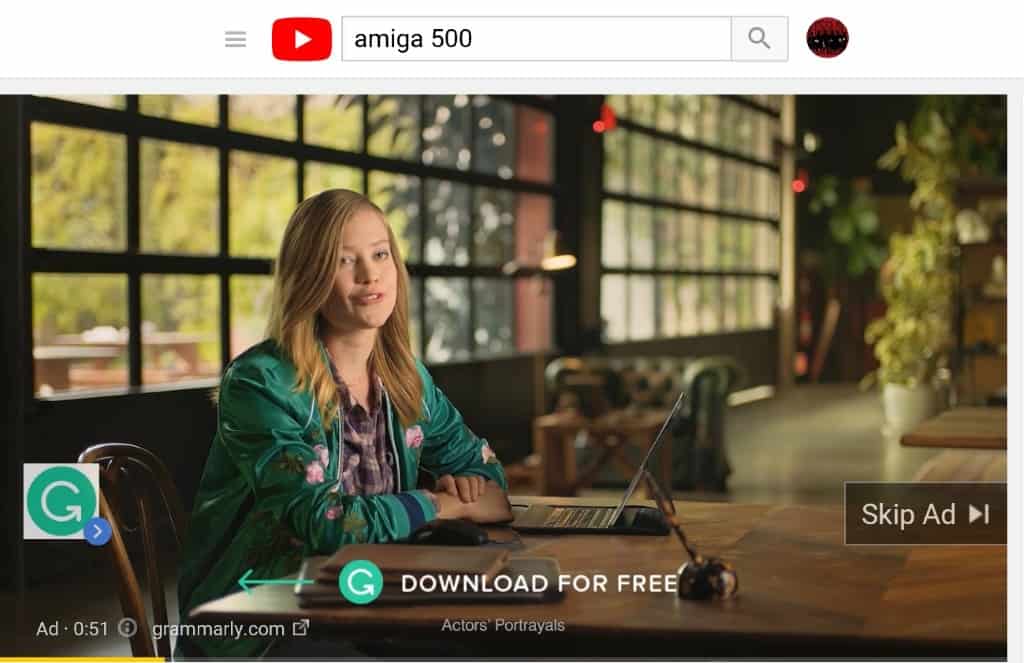
3. Non-Skippable In-Stream Video Ads
Non-skippable video ads may appear before, during, or after the main content and typically last between 15 and 20 seconds.
For startups, these Non-Skippable Ads are among the best choices to enhance brand awareness.
Here's an example:
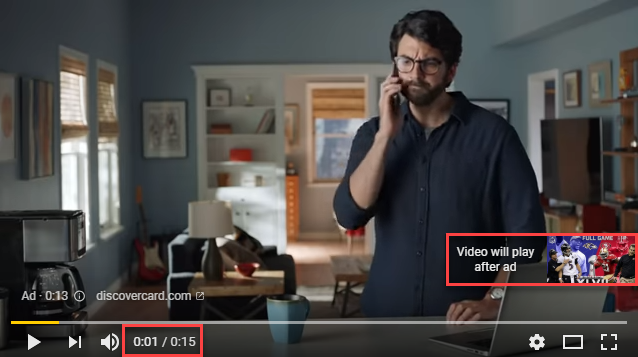
If the video on YouTube is 10 minutes or longer, non-skippable mid-roll ads may appear midway through the video. When watching on a desktop, viewers will see a countdown of five seconds before the ad plays, while on the app, yellow markers will indicate where the ads are placed.
4. Overlay ads
Overlay ads, displayed below, are a type of banner ad that floats at the bottom of the video. They are an ideal addition to your other in-stream video campaigns, as they can help you advertise your product without being intrusive while still reaching your desired audience.

5. Bumper Ads
Bumper ads are ads that last just six seconds and play before a viewer's chosen video, with no option to skip them.
Here's an example:
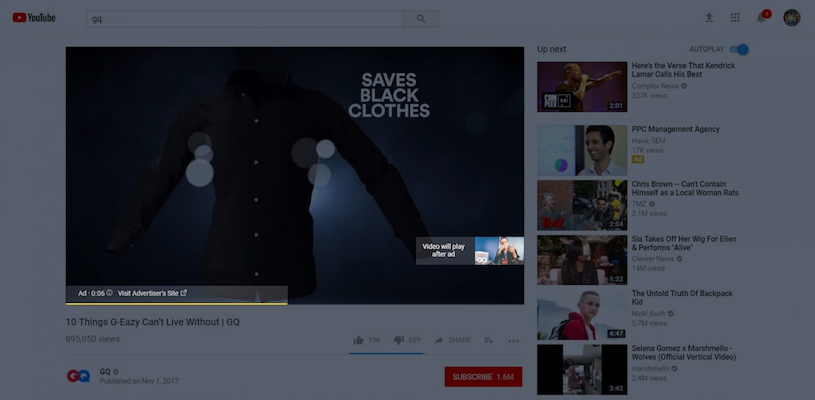
Getting Started with YouTube Ads
With a basic understanding of the different types of ads that can be run on the YouTube platform, let's cover the nuts and bolts of launching a YouTube ad campaign.
Step 1: Upload your Ad Video to YouTube
In order to run a YouTube ad, it is necessary to upload the ad video to YouTube first. You can do so by visiting https://studio.youtube.com/ and uploading your video.
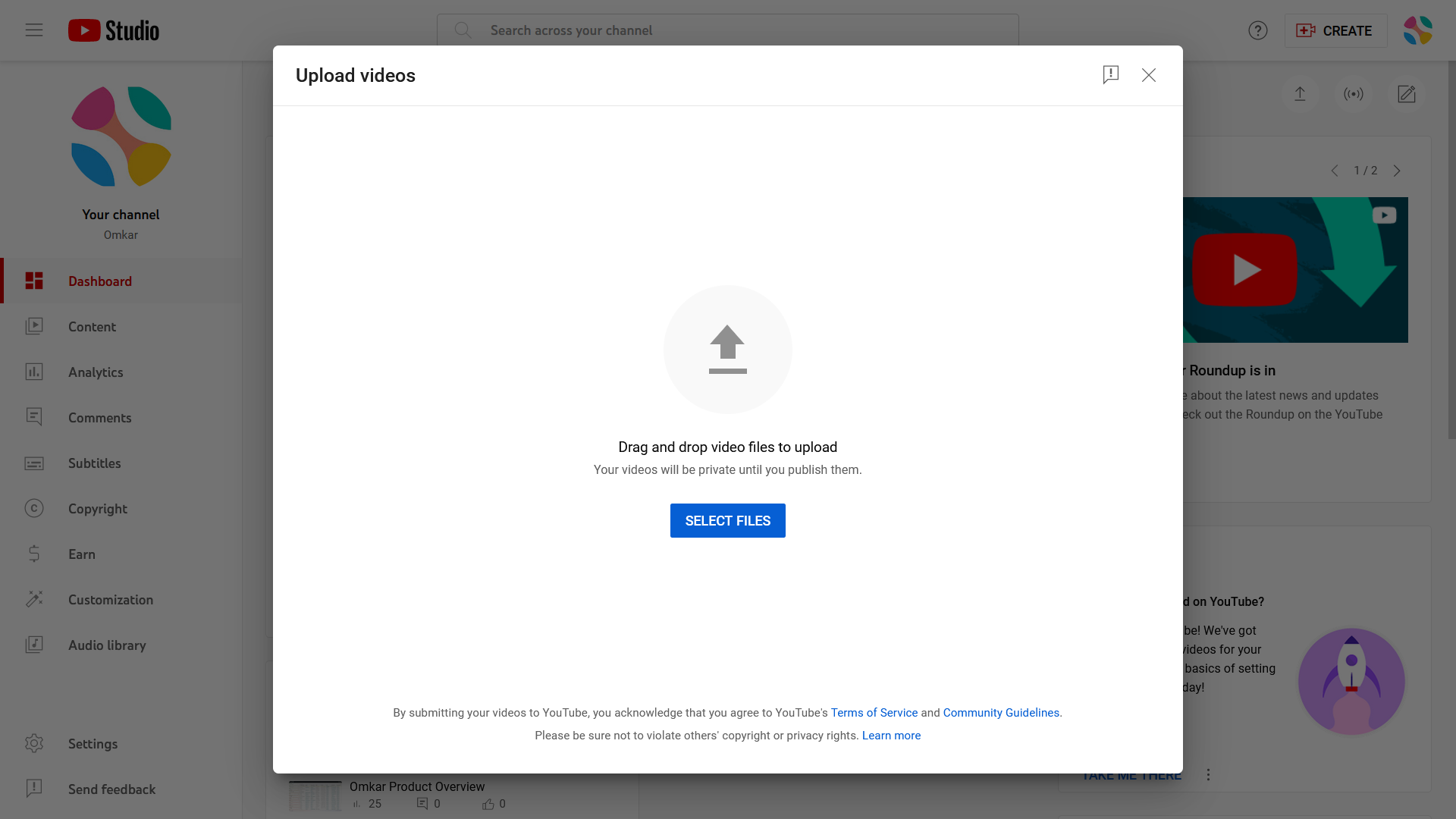
Step 2: Create Google Ads Account
In order to run YouTube ads, it is necessary to have a Google Ads account. So visit ads.google.com and create a Google Ads account.
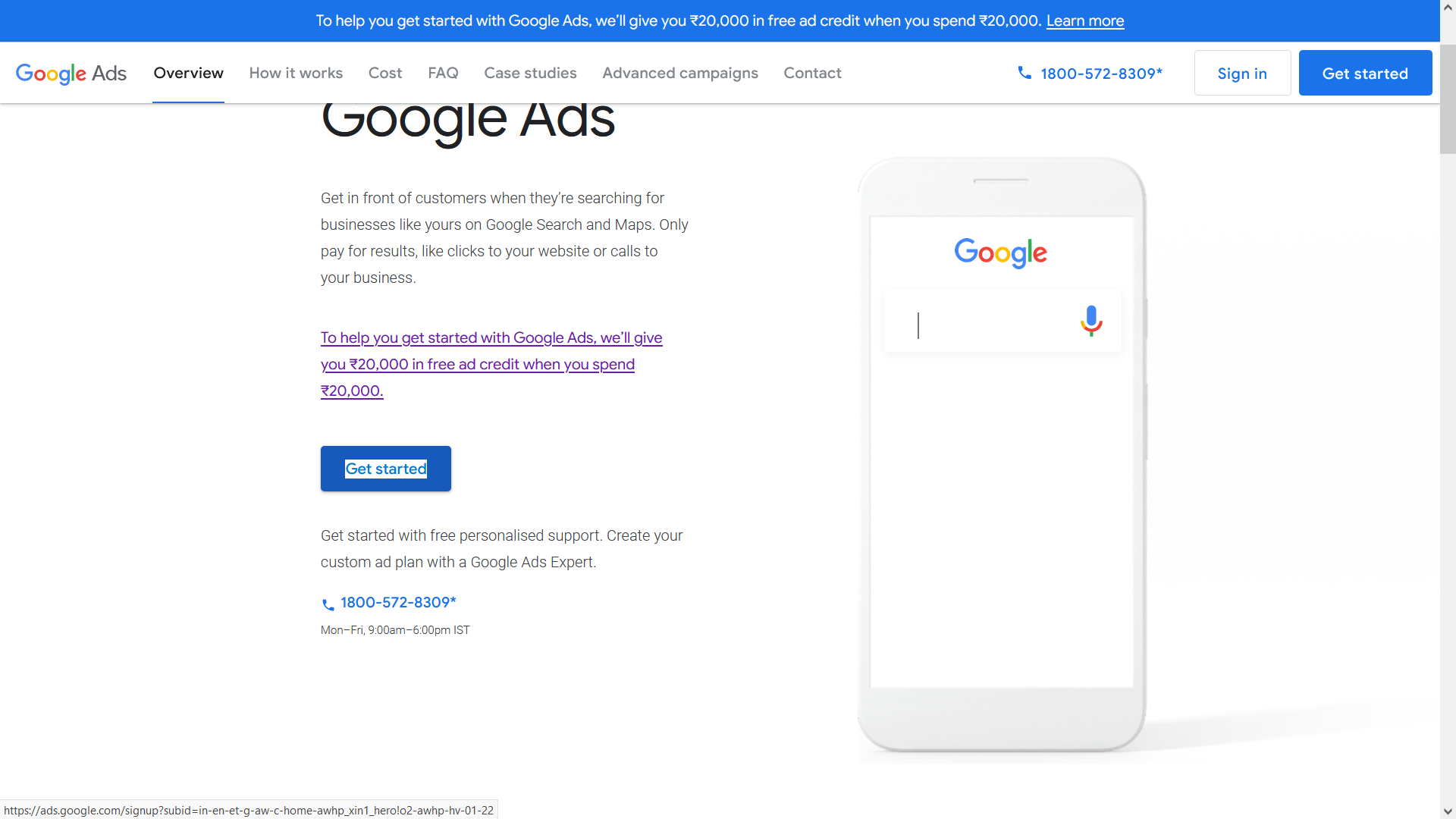
Step 3: Create new Campaign
To create new Campaign press button that says “+ New Campaign” On the Google Ads Dashboard,
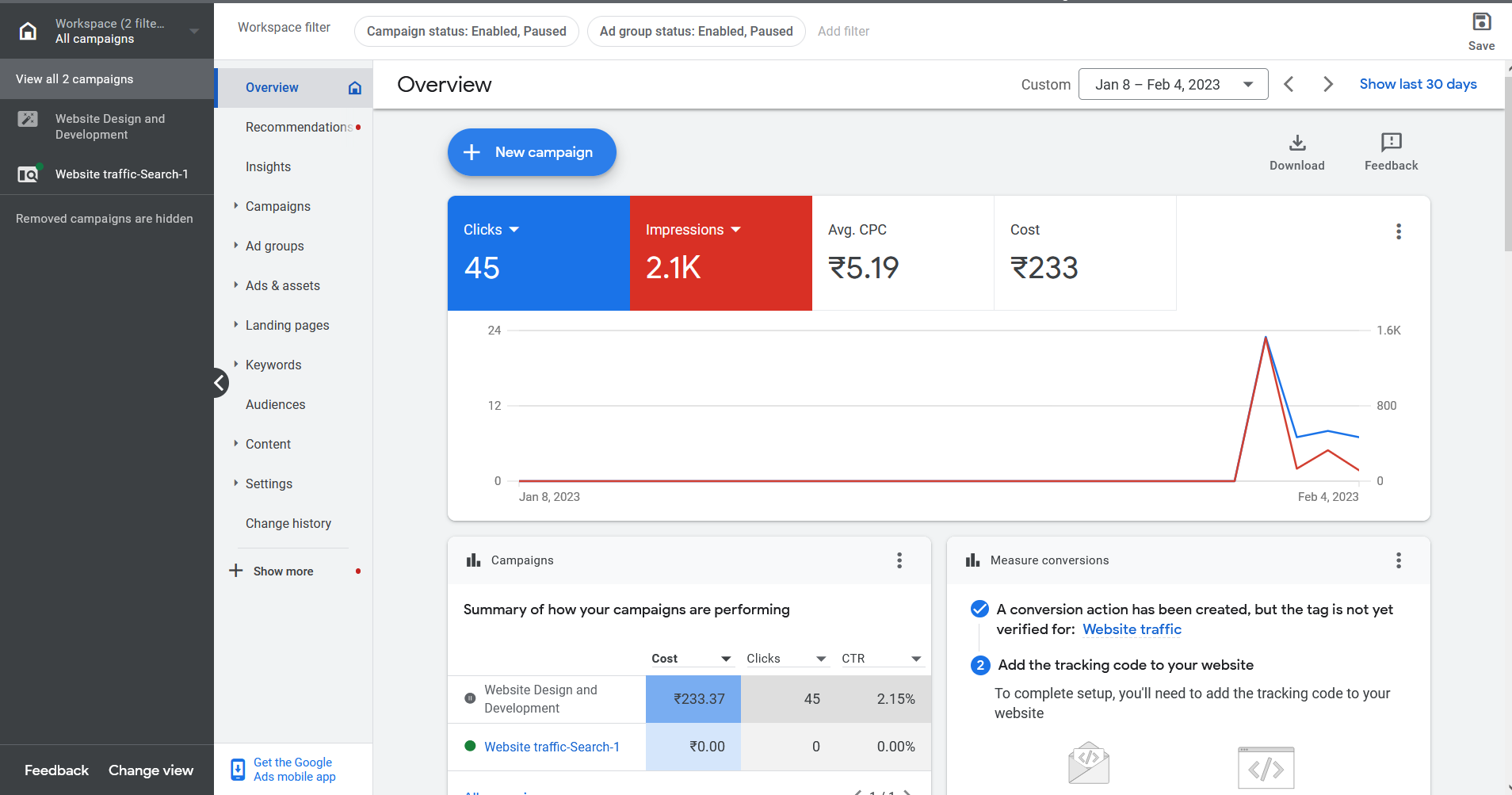
Step 4: Choose campaign objective
When setting up a campaign in Google Ads, you will be presented with various objectives to choose from which are
- Sales
- Leads
- Website traffic
- Product and brand consideration
- Brand awareness and Reach
- App Promotion
- Local Store Visits and Promotion
- Or you can create a campaign without a goal's guidance.
We will be running in-video ads (ads that play during the video), so select the "Brand awareness and Reach" option.
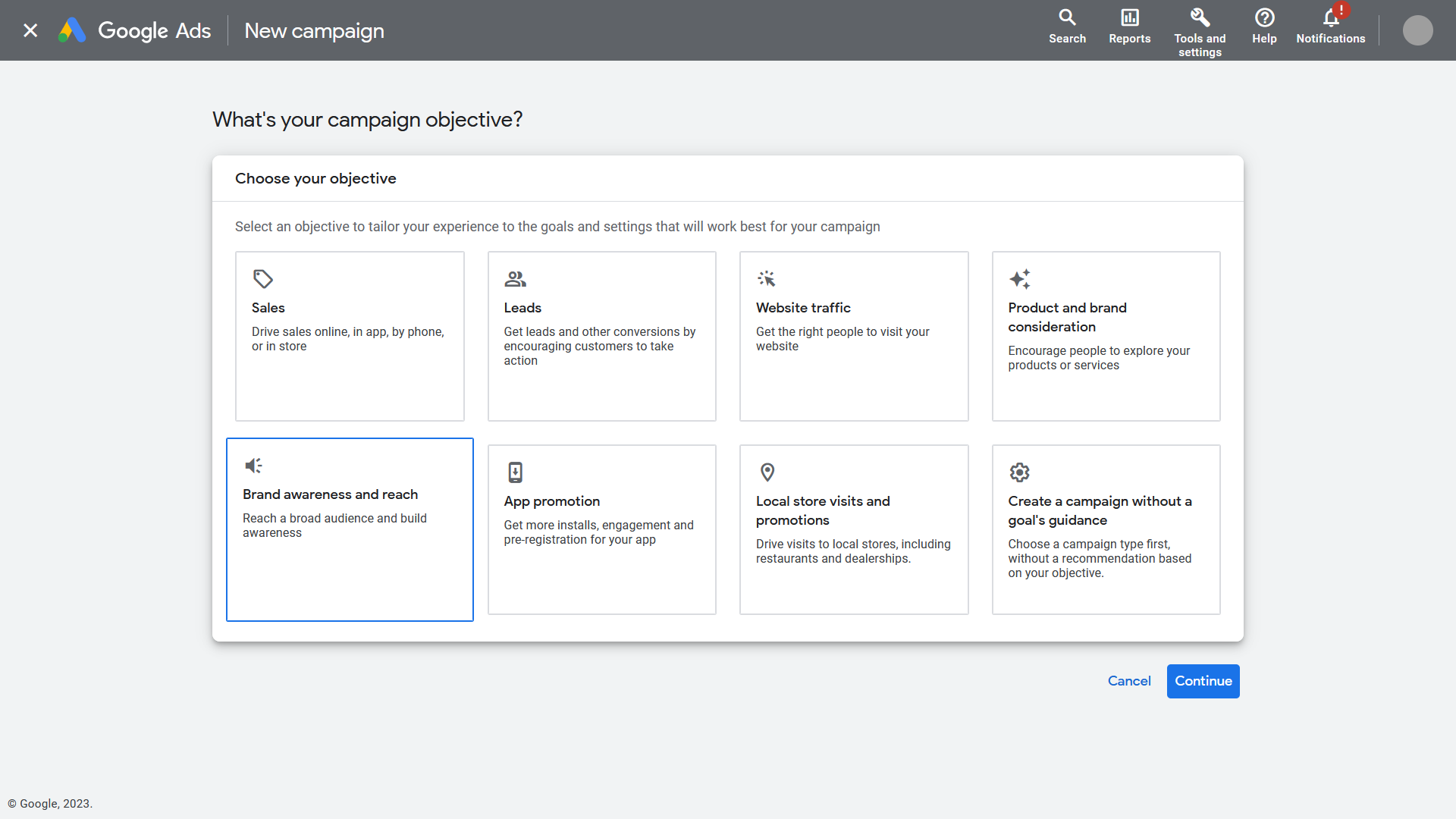
Step 5: Choose a campaign type
When selecting the campaign type, you will have two options:
- Display: This includes all types of Google ads, such as Google Search Ads, text, and shopping.
- Video: This primarily includes YouTube Ads.
Since you are looking to run video ads, select the "Video" option.
Once selected, click on the "Continue" button.
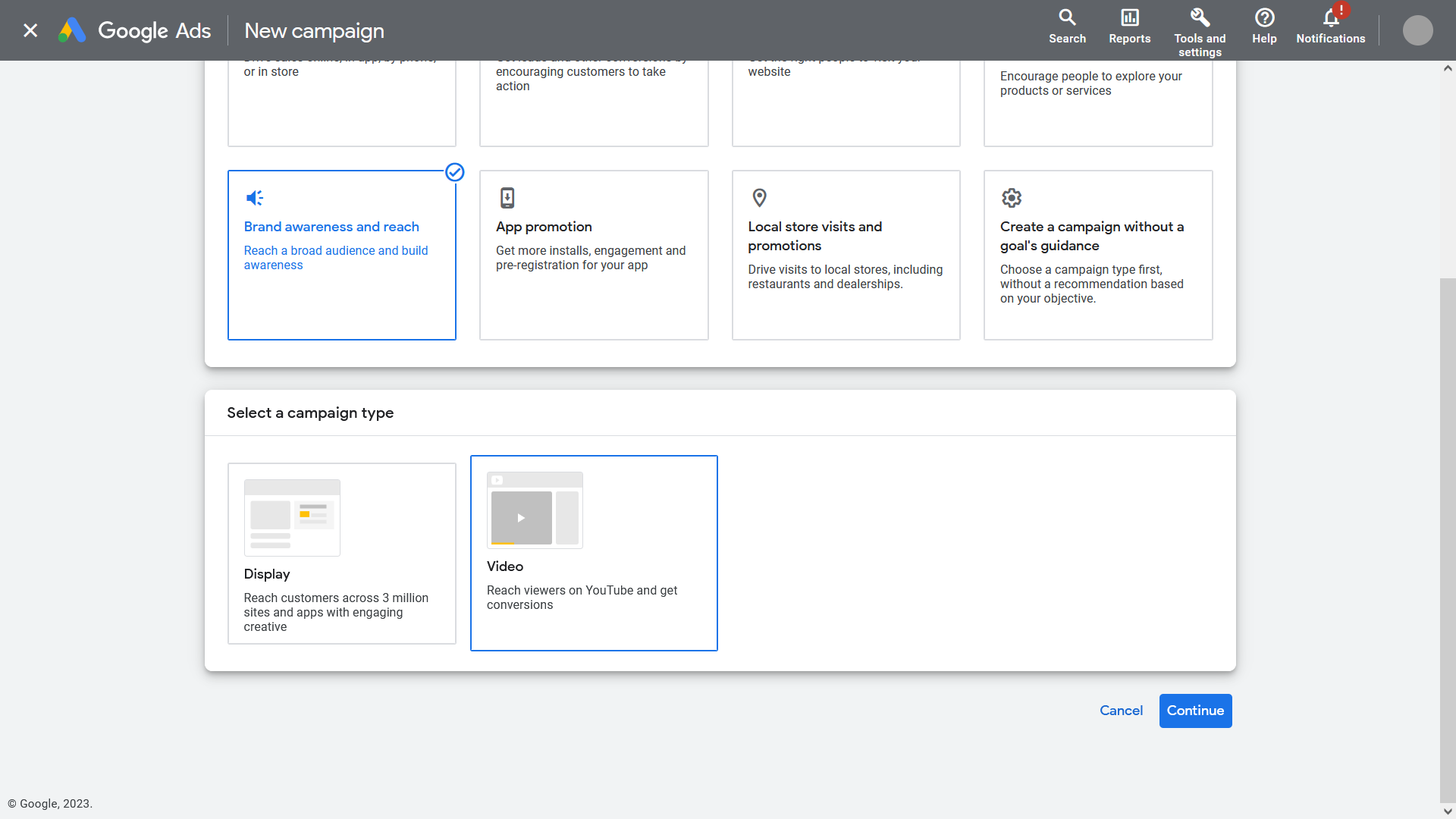
Step 6: Choose campaign subtype
Select your campaign subtype, the default option of a Video Reach campaign is suitable.
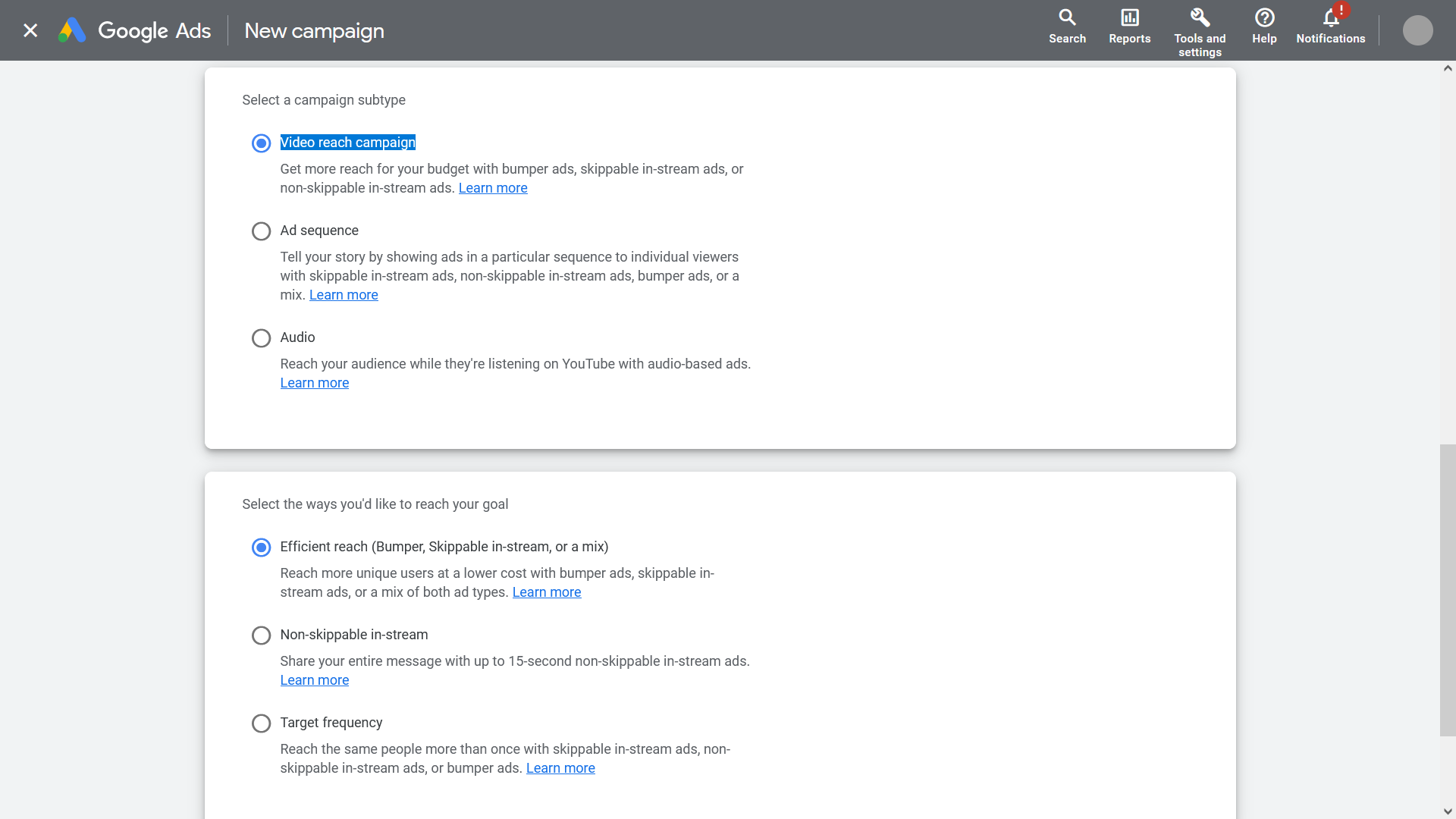
Step 7: Choose campaign Reach Strategy
When it comes to selecting a reach strategy, you have three options to choose from:
- Efficient reach: This is a mix of both skippable and non-skippable ads, and is cheaper than the non-skippable in-stream and target frequency strategies.
- Non-skippable in-stream: These ads are shown while a video is playing, and the viewer is required to watch them.
- Target frequency: This strategy involves targeting an audience repeatedly.
Please choose the option that best fits your campaign goals, or you can go with the default "Efficient reach" strategy.
Once selected, click on the "Continue" button.
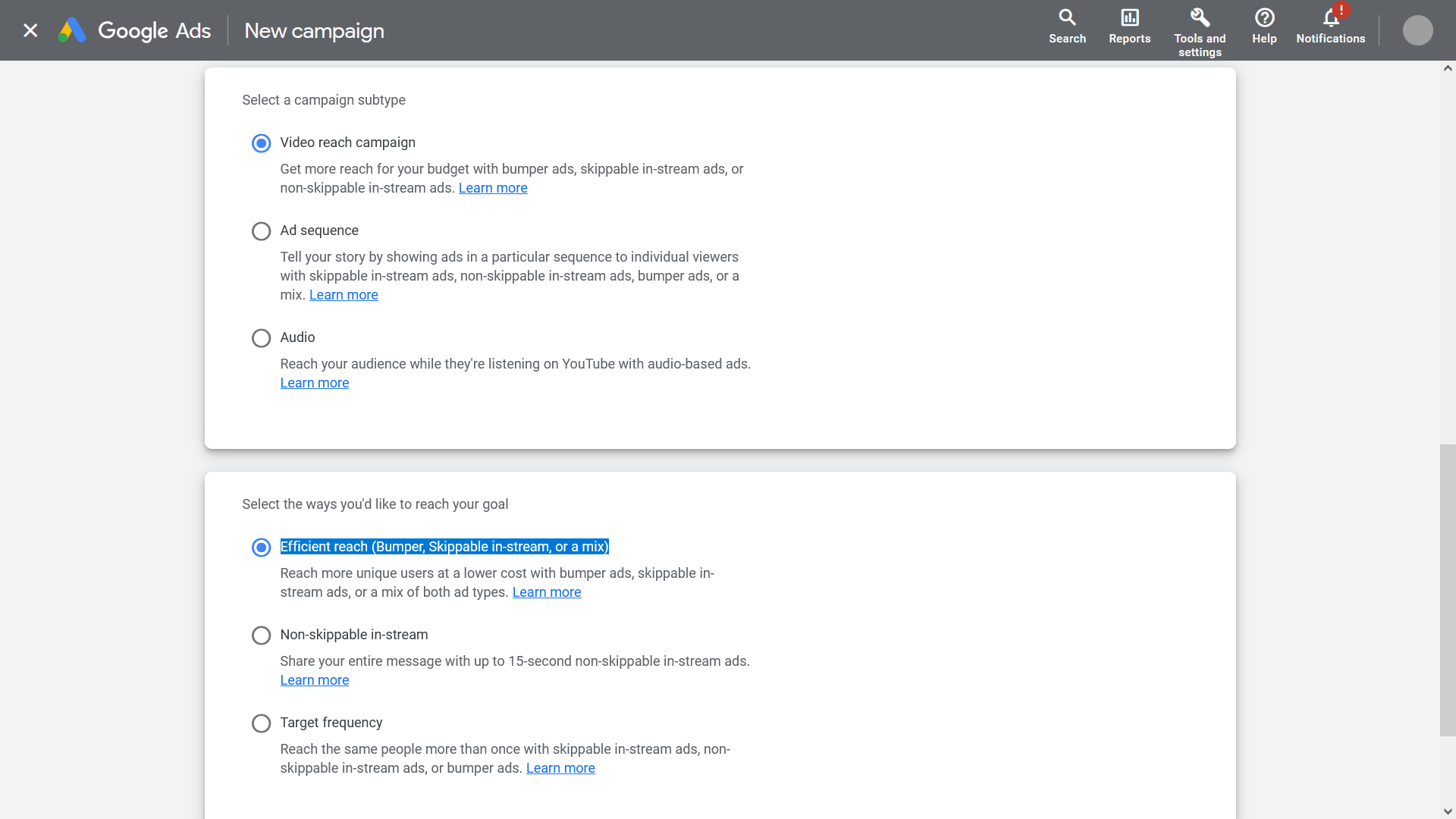
Step 8: Choose a campaign name
Finally, give your campaign a descriptive name that will allow you to easily locate, manage, and optimize it in the future.

Step 9: Enter the budget of your campaign
Now, you need to select your budget type, which offers two options:
- Campaign Total Budget (Popular): This is the amount you are willing to spend on the campaign in total.
- Daily Budget: This is the amount you are willing to spend on the ad on a daily basis.
If you selected the "Campaign Total" budget type, you will also need to specify the end date of your campaign.
.png)
Step 10: Choose where your ads will appear
You can choose from three options regarding where your ads will be displayed:
- YouTube search results (i.e., ads will be displayed in YouTube search results)
- YouTube videos (i.e., ads will be displayed on YouTube videos, channel pages, and the YouTube homepage)
- YouTube Partners on Display Network (i.e., ads will be displayed on non-YouTube affiliated websites, etc.)
.png)
Step 11: Choose the language and location of your target audience.
choose the language and location where you would like your ads to be displayed, please note that targeting countries like India will result in lower costs for your campaigns.
.png)
Step 12: Choose related video
You can opt to include related videos that will be displayed below your advertisement. You have the ability to include a maximum of five related videos.

Step 13: Choose the type of People you want to Target
Google allows you to reach your desired audience based on:
- Demographics: such as gender, age, and income
- Interests or Audience Segments: such as web design and services or advertising
Depending on your product, it may be beneficial to target a younger audience aged between 18 and 34.
You could also explore various targeting options based on your intuition to determine which audience group generates the most conversions.
.png)
Step 14: Choose the type of Content where you would like to show your ads
Google also offers the ability to select the type of content where you would like your ads to be displayed based on:
- Keywords: such as find leads, get leads, lead generation
- Topics: such as business and industrial, computers and electronics
- Placements: such as specific YouTube channels like CodeWithHarry or specific YouTube videos like "Python Tutorial for Beginners in Hindi (with Notes)" by CodeWithHarry.
You can experiment with different options based on your intuition to see which yields the best conversions.
.png)
Step 15: Choose your Video
Now, add the ad video that you uploaded to YouTube in the first step, along with your website URL and any relevant call-to-action for your video. Please refer to the example image below.
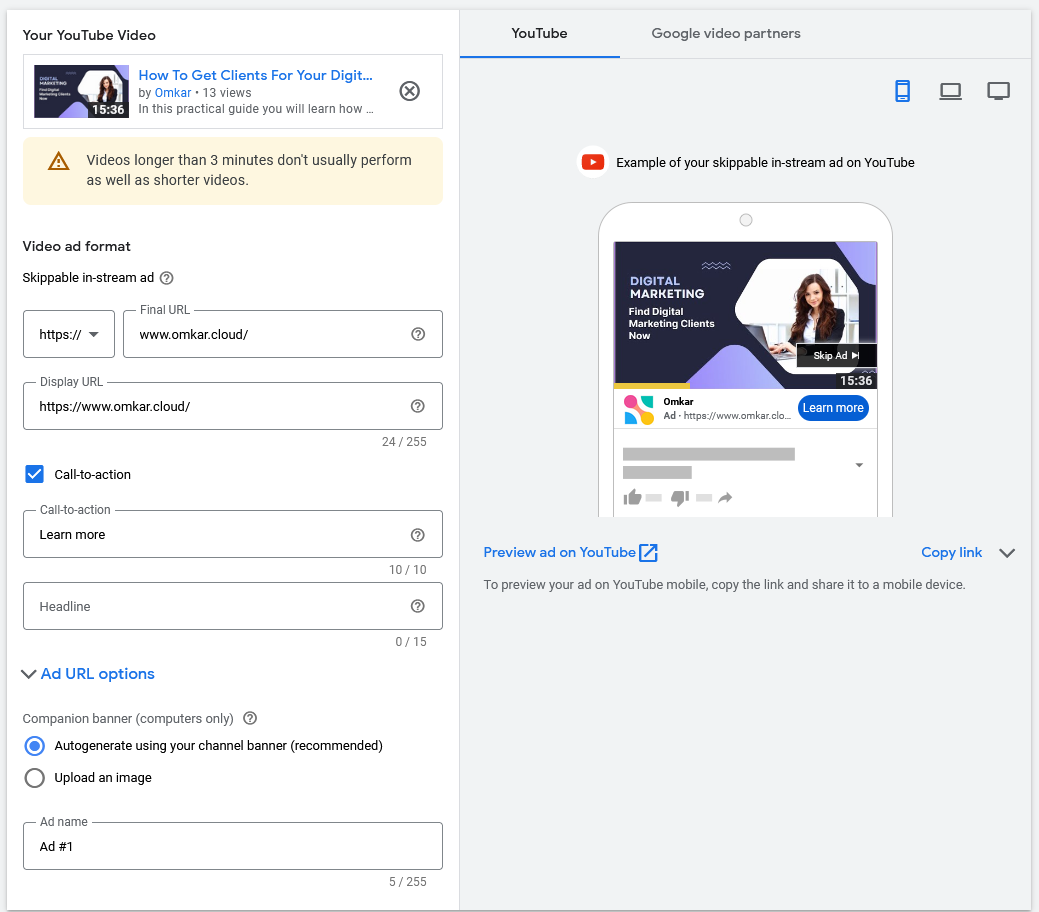
Step 16: Enter Bid Price
Enter the bid amount that you are willing to pay per 1000 views (CPM).
.png)
Step 17: Publish Campaign
Review your campaign settings and click on the "Continue" button to create the campaign.
.png)
Tips on how to optimize YouTube advertising
Your ad's success on YouTube is heavily dependent on how well it connects with people, despite the platform's powerful and endlessly customizable advertising engine. Therefore, the creative decisions you make are critical. Here are some of our most effective strategies for producing impactful video ads on YouTube.
Study your competitors
Studying your competitors' YouTube advertising strategies is an excellent way to know what works and what doesn't in your industry. Here are some examples of how to conduct competitor research for YouTube advertising:
Identify your competitors
You know best who your Competitors are. So go ahead and make a list of your Competitors.
Analyze their content
Take a look at your competitors' YouTube Channel and look for patterns in the type of content they produce.
For example, if your competitor produces a lot of 10-minute HIIT workouts, this might indicate that this type of content is popular with your shared audience.
Investigate their ad strategy
Explore the YouTube ad strategy of your competitors by searching for keywords related to your product and identifying the types of ads they are running. ****
This can include pre-roll ads, mid-roll ads, or display ads. Analyze their targeting, messaging, and creative elements to identify any patterns.
Call-To-Action
In marketing, it is a best practice to include a call-to-action (CTA) at the end of any piece of content. Here are some examples of CTAs you can use in your YouTube ads:
Visit your website
If you're advertising a product or service, encourage viewers to visit your website to learn more. For example, "Visit our website to shop now.".
Keep in Mind to have an Attractive Landing Page when using this Call to Action.
Sign up for a free trial
If you're offering a free trial of your product or service, encourage viewers to sign up to try it out. For example, "Sign up for a free trial today." Follow you on social media
If you have a strong social media presence, encourage viewers to follow you on platforms like Instagram or Twitter. For example, "Follow us on Instagram for behind-the-scenes content."
Keep trying till you hit Positive ROI
In the world of YouTube advertising, it's crucial to continuously experiment with different approaches to determine what works best for your business. Here's why:
- Your ads may not be engaging enough: If this is the case, try experimenting with different ad ideas. Look to your competitors or other brands for inspiration.
- You may be targeting the wrong keywords: To fix this, think carefully about your target audience and choose keywords based on their interests and behavior.
- You may not have a product-market fit: If this is the issue, you may need to either remodel your product or create a new one.
Remember to learn from any failures and identify areas for improvement. Tweak your approach and keep trying until you find a strategy that works.
It's important to keep in mind that YouTube Ads are effective, which is why businesses spend billions of dollars on them every year. The most critical factor when running ads is to ensure a positive return on investment (ROI). As long as you have a positive ROI, you can continue to scale indefinitely.
Summary
In this article, you gained a thorough understanding of YouTube Advertising. The key takeaways from this article include:
- YouTube Ads are an excellent advertising option because videos have a lasting impact on viewers.
- You learned about various types of ads, such as:
- In-feed video ads that appear in users' feeds and search results
- Skippable in-stream video ads, which are long ads that can be skipped
- Non-skippable in-stream video ads that play during videos and users must watch them
- Overlay ads that appear as a rectangular banner while videos are playing
- Bumper ads that play at the beginning of videos and users must watch them
- You learned how to create and run your ad campaign.
- You learned that to optimize your YouTube ads, you should:
- Take inspiration from your competitors.
- Use calls to action at the end of your ad.
- Keep trying until you achieve a positive ROI.
Next Steps
To benefit from the Knowledge you have gained it is best to practice it. Follow these steps to put your knowledge into action:
- Analyze your competitors' ads to gain insight into the types of ads you should create.
- Launch a campaign by following the steps outlined in "Getting Started with YouTube Ads."
- Keep an eye on your ads and make necessary improvements to optimize their performance.
Remember that the most important thing when running ads is to make sure that when you put $1 in Ad, you get more that $1 in Return meaning that you have, ensuring a positive return on investment (ROI). Understand that, Achieving a positive return on investment with ads typically involves experimenting with multiple ads as it is a process of trial and error.
I wish you the best of luck and success with your Ad Campaign!
🙏 Dhanyawad 🙏
FAQs
How to track the performance of my ads?
You can use YouTube’s Analytics Dashboard which provides detailed data on your YouTube channel's performance, including views, engagement, and demographics.
You can use this data to optimize your ad campaigns by targeting specific audiences, creating more engaging content, and refining your messaging.
Are there any tools available to help optimize my YouTube Channel?
Here are some of the most popular tools, apart from Analytics Dashboard on YouTube:
- VidIQ: This is a Chrome extension that provides insights into your YouTube channel's performance, including keyword research, optimization tips, and competitor analysis. Furthermore, we personally use VidIQ to search for tags and check competitors for a keyword.
- TubeBuddy: This is another Chrome extension that provides similar insights to VidIQ, as well as additional tools for managing your YouTube channel, such as A/B testing, bulk processing, and scheduling.
How much does it cost to advertise on YouTube?
Sorry, we are unable to provide you with a precise figure as the cost of advertising on YouTube varies depending on the ad format, targeting options, and bidding strategy you choose. YouTube offers a variety of pricing models, including:
- Cost per view (CPV)
- Cost per impression (CPM)
- Cost per click (CPC).
It's worth noting that every time you create an Ad using Google AdWords, YouTube displays the corresponding cost of the Ad.
Are there any restrictions or guidelines to follow when creating an ad for YouTube?
Here are some important points to keep in mind:
- Ad content: Advertisements on YouTube must comply with YouTube's policies, including its community guidelines, terms of service, and advertising policies. Ads must be appropriate for a general audience and may not include content that is violent, offensive, discriminatory or sexually suggestive.
- Ad formats: YouTube offers several ad formats. Each format has its own guidelines and requirements, so make sure to review them before creating your ad.
- Ad disclosure: If your ad promotes a product or service, you must disclose this information clearly and prominently in your ad. This includes disclosing any sponsorships or endorsements.